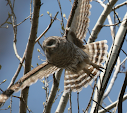
Last weekend, after observing the Orange-billed Nightingale Thrush, I happened across Roubaix Lake as I drove towards Wind Cave National Park, and stopped in to see what was around. The lake was nice, and the camping area was packed, but there wasn't much in the way of waterfowl around. What I did see was this bird that looked to be a Pine Siskin, but with a few differences that made me wonder. Please take a look, and feel free to comment if I am off base and missing something obvious, or if you have insight as to a particular age or hybridization that would lead to these traits.
First the traits that lead me to Pine Siskin: It is a heavily streaked, smallish bird; that has a relatively long pointed bill, and a sharply forked tail. The wingbar pattern looks right, as well as that of the folded flight feathers.
In addition, the bird was in the right habitat for Siskins, foraging for insects in some Ponderosa Pines near the edge of the lake. When I first spotted the bird it was hunting for flying insects from a perch in a very flycatcher like manner. Then it crossed the trail and worked over a few cones, eventually pulling an insect from within (see below). Those behaviors are both documented for the Pine Siskin in the Cornell Lab or Ornithology's Birds of North America Online.

However there are also some things that are a bit off. This bird is more 'black on white' than a typical Pine Siskin showing yellow, but then feather color can wear down over time and this bird may have just washed out since its last molt. The eye-ring is much more distinct and white than I would expect as well.

The underside of this bird's tail has a white patch. It is visible in the top picture, partially obscured by the branch. After much searching I am unsure if that is to be expected in a 'pure' Pine Siskin or not. It may just be a weird angle, that is not often photographed.

I added this picture because it even in wingbeat this bird isn't showing much yellow in the flight feathers. Again, this could be due to feather wear, but I am unsure.

Finally, there was the yellow chin. I noted an impression of it in the field, and was unsure in earlier pictures if I was just catching a trick of the light, but this picture confirmed that there was a distinct yellow chin on this bird. Pine Siskins can carry a yellowish tint to their underparts, but I am not aware of an isolated yellow chin showing up.
I have been flipping through field guides and websites trying to nail down an ID on this one, and so far I haven't found it. Flycatchers and Finches, Vireos and Warblers, I have even looked for juvenile Woodpeckers or Thrushes that would fit, but so far nothing concrete. Even if it remains a hopeless mutt, it was an interesting bird to watch, and plucking a juicy green bug from a pine cone is even better.




































